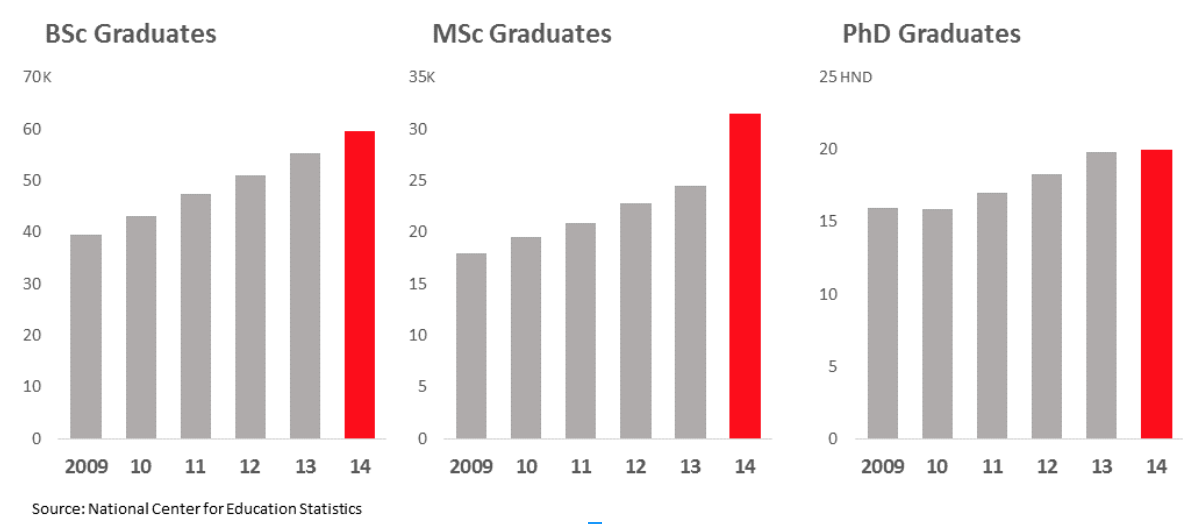Traditional coding education in the form of university degrees is growing in popularity, but also in cost. In the US the number of students expected to attend American colleges and universities is 20.4 million, an increase of 5.1 million since fall 2000. The number of graduates with a Bachelor’s degree in Computer Science in 2014-15 was 59,581 – a 50.5% increase from 2009-10 (Figure 4). Similarly, the number of graduates with Master’s degrees in 2014-15 was 31,474, which is a 75.3% increase on 2009-10 numbers.

Figure 1: Number of Graduates in Computer Science in the US
The coding education boom
In the UK, Computer Science is a STEM subject taught at the majority of Higher Education Institutions (HEIs). In each of the years 2008-2014 more students have begun Computer Science undergraduate degrees than have started Physics, Chemistry, and Mathematics combined. After a big rise in the number of Computer Science students in the 1990s following the dot.com boom, the number of entrants decreased to about 17,500 full-time entrants in 2007-2008, and since then have been rising asymmetrically. In 2014-15 the number of entrants was close to 21,000. This can be seen in Figure 2.

The benefits of traditional coding education
A computer science, engineering, or mathematics degree is often regarded by employers as a signal that the student can learn coding. The degrees, especially engineering and mathematics, don’t in themselves teach strict coding but employers see graduates of those subjects as smart and hard working enough to learn how to become a software developer. Moreover, a degree trains the mind and develops qualities like perseverance and time-management in students, skills they will use throughout their life. A degree from a prestigious university, such as Oxbridge or the Ivy League, is seen as an additional signal for employers that their prospective employee is smart, as admissions are highly selective and the aforementioned institutions are known for academic excellence.
The digital tech skills gap
Currently, formal education doesn’t fill the gap in the supply of much needed tech skills. The UK government recently commissioned a report led by Sir Shadbolt into why the degree of Computer Science had the highest dropout rate in the UK and highest unemployment rate. The report identifies that supply of Computer Science graduates and needs of employees are misaligned. Insufficient technical knowledge among graduates is quoted most often by employers as the reason for lack of employment offers. The report also found that this is due to the fact that the skills needed for tech jobs like software development do not match what UK universities currently teach students.
Filling the digital tech skills gap
The pathway to creating more trained software engineers consists of 1) improving programming education and 2) ensuring its proliferation among a greater number of learners. This is what many governments, such as the UK, have realised and focused on. Although few countries have mandated Computer Science (CS) classes in senior years of High School education, the number of countries offering this has been growing steadily. In the European Union (EU) 15 countries have already integrated computer science into their senior curriculum in some form, while 9 countries in the EU have integrated or will integrate CS education at a primary school level. In the UK, the subject of ICT has recently been replaced with ‘computing’ across schools’ and millions of pounds put forward by the Department for Education to work with a group known as Computing at School (CAS) to head up the retraining of UK educators in the field.
Making coding education more accessible
In the US, although there has been a lack of uniform country-wide computer science education legislation introducing mandatory classes in programming, individual states like Idaho have passed bills introducing computer science lessons and supporting resources in public schools. Code.org, a nonprofit aimed at expanding pupils’ and students’ access to computer science education in America, has raised over $60 million from Microsoft, Apple, Google and Salesforce, and persuaded two dozen states to improve access to computer science education. It also created free introductory coding lessons as part of the Hour of Code initiative, in which even President Barack Obama took part. Former President Obama additionally highlighted this need in his 2016 State of the Union Address, with a commitment of over $4 billion to fund the Computer Science for All initiative to train school children and educators across the country in CS. Thus a concerted effort is being made at the level of secondary education.
The downfall of traditional coding education
Universities, however, do not deliver effective coding education as this has never been their main job. Computer Science, Mathematics and Engineering degrees at universities focus on exceptionally important theoretical concepts that are crucial in their own right, but very different from the skills required by employers. Such skills are the skills that non-traditional coding educators focus on. In university, students build their analytical skills with problem sets and tests and learn to engage with research literature. Course content in universities is also slow to change, as the bread and butter of academic learning are research papers. One must adhere to university hierarchy structures and bureaucratic red tape. It takes time before those are approved by the majority in the field in order to become a must-learn in the discipline. This model is not likely to change as this is not the main role of universities. When freshly graduated employees enter the workplace, employers have to spend time to bring them onboard. The average time for a new employee to become fully productive is on average 1-2 years according to Training Industry Quarterly.
Another problem is the lack of personalised feedback. Students are often in large classes that do not cater for individual attention and mentoring, especially not at a line by line in code level, and the volume of students taught means that even where tutorial group systems are implemented, the degree and quality of feedback from tutors fails to meet students’ demands for learning support. Assessment methods tend to be summative in nature, rather than focusing on formative assessment, due to the scale.
The cost of traditional coding education
Also deterring potential students is the rise of university tuition fees. For British and EU citizens it costs approximately 9,250 pounds per year, and for international students the tuition fees grow to tens of thousands of pounds annually. US colleges are even more expensive with the average tuition per year in private non-profit universities rising by 28% since 2012. At private colleges the average tuition is currently more than $33,000 per year, and at public colleges it is $9,650 for state residents. Although at least two-thirds of students benefit from bursaries, scholarships, and grants; the current total American student debt adds up to over $1.31 trillion and has a default rate of 11.2%. The average student in the class of 2016 has $37,172 in student loan debts according to Q4 2016 New York Federal Reserve.
With these factors in mind, the need for financially viable informal coding education is increasing, and it is becoming clear that it is often easier to learn the skills needed to be an effective developer who meets industry requirements and standards through online courses and project-based work experience.


